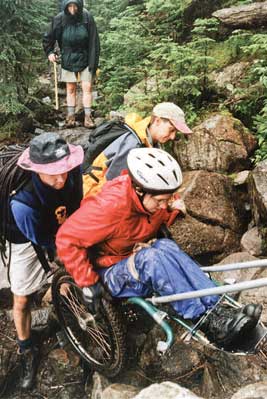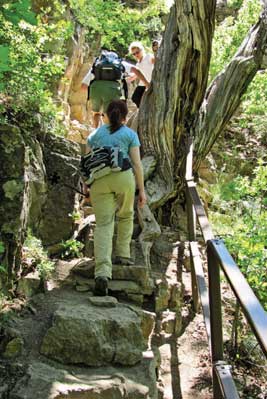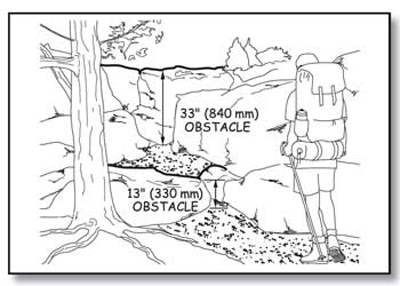General Exceptions in FSTAG
Some public lands are reasonably well suited for pedestrian travel. Other public lands are rocky, soggy, excessively steep, or otherwise less well suited to casual foot traffic. Two general exceptions are provided in FSTAG, section 7.2 to ensure that accessibility is provided to the extent appropriate to the setting where it will have the most benefit, be practicable, and provide a meaningful hiking opportunity.
Document the basis for the determination that either of the general exceptions applies to a trail or a portion of a trail and maintain the documentation with the records of the construction or alteration project. In addition, if General Exception 2 applies, send notification to the U.S. Access Board. Documentation and notification requirements are explained in "Documenting Exceptions and Notifying the U.S. Access Board about Exemptions" of this guidebook.
General Exception 1 allows deviations from the technical requirements if a condition for an exception prohibits full compliance. It's not a complete exemption from the provision, because it requires that the technical requirement must still be met to the extent practicable.
For instance, if Condition for an Exception 3 prohibits importing several tons of stabilization material to ensure that the surface of a trail in a nonmotorized area will be firm and stable during the primary season(s) of use under normally occurring weather conditions, you must still make sure the surface is as firm and stable as is practicable. For instance, if relocating a section of trail a few feet laterally will achieve firmness and stability with native soils during the dry portion of the season or even during part of the wetter season, you must relocate that section. Such measures are practicable and should be utilized. General Exception 1 only applies to the portion of the trail where the condition for an exception exists. On all other sections of the trail, ensure that technical requirements are met. All of the unaffected technical requirements must be met for the full length of the trail, including the section where the condition for an exception prohibits full compliance with the particular technical requirement. Practicable means reasonable rather than technically possible. (See TERMINOLOGY TIP—What's practicable?, page 32.)
Another example of the use of General Exception 1 is when construction of a trail appears to fall under Condition for an Exception 4, where compliance is not possible because the cultural, historic, or significant natural features are protected or are eligible for protection under Federal, State, or local law. For instance, consider a situation where a trail is needed between a stream with endangered aquatic species and a cliff with petroglyphs on it and you can't get the required trail width without either filling part of the stream or destroying some petroglyphs. A narrower trail would be allowed past the petroglyphs. However, the other technical requirements still apply to that stretch of trail and the technical requirement for width still applies to all the rest of the trail.
Design Tip
Compliance is required on both sides of a deviation from the technical requirements.
Although accessible design is based on wheelchair dimensions, clear space, maneuvering room, and reach ranges, only 4 percent of people with disabilities use wheelchairs. The majority of people who have mobility limitations don't use a wheelchair. They either use no assistive devices or rely on crutches, canes, walkers, or braces. They may be able to get around or over an obstacle without too much difficulty. Although steep terrain may be difficult, it may be manageable for limited distances.
Likewise, a person using a wheelchair might need assistance to make it up a steep grade (figure 124) or to get over an obstacle, but after that challenge, the individual can continue on the trail independently if the rest of the trail complies with the accessibility guidelines.

Figure 124—Members of the Northeast Passage hiking team assist their teammate up a steep part of the Galehead Trail. She only needs assistance for a short distance. Photo credit: Northeast Passage, Durham, NH
General Exception 2 addresses extreme environmental barriers that are effectively impassable and trails with numerous environmental barriers that can't be eliminated. These barriers can make the rest of the trail unreachable for many people with mobility limitations. General Exception 2 may be considered only after applying General Exception 1 so that the trail sections where full compliance with the technical requirements can't be achieved are identified. Then evaluate the entire trail comparing the trail sections that can and can't meet the full technical requirements to determine whether it would be impracticable for the entire trail to comply with the accessibility requirements.
The following condition criteria have been accepted by the U.S. Access Board for identifying when extreme environmental barriers may exempt an entire trail from technical accessibility requirements:
-
A combination of running slope and cross slope exceeds 1:2.5 (40 percent) for more than 20 feet (6 meters) (figure 125).
-
An obstacle 30 inches (760 millimeters) high or more crosses the full tread width of the trail (figure 126).
-
The surface of the trail is neither firm nor stable for a distance of 45 feet (14 meters) or more.
-
The tread width of the trail is 12 inches (305 millimeters) or less for a distance of 20 feet (6 meters) or more.
-
15 percent or more of the trail does not fully comply with the technical requirements.

Figure 125—The combination of running slope and cross slope on the trail to Hanging Lake is so severe for such an extended distance that the entire trail was exempted from the technical requirements.

Figure 126—The 33-inch (840-millimeter) rock face is an example of an extreme environmental barrier.
Some long-distance trails, such as the Continental Divide, Pacific Crest, Appalachian, and Florida National Scenic Trails and the Nee-Me-Poo National Historic Trail, span many districts or forests. For these trails, only the length of trail planned for construction or alteration within the current planning period is considered when figuring the 15 percent, not the entire length of the trail. This principle applies even if the planning period is several years long. Consider connected sections of trail that will be constructed or altered over several years, together. Do not consider unconnected segments of trail that are covered by the same planning process together, unless there is a special circumstance where several segments function together to access one attraction or serve one purpose.

User Comments/Questions
Add Comment/Question